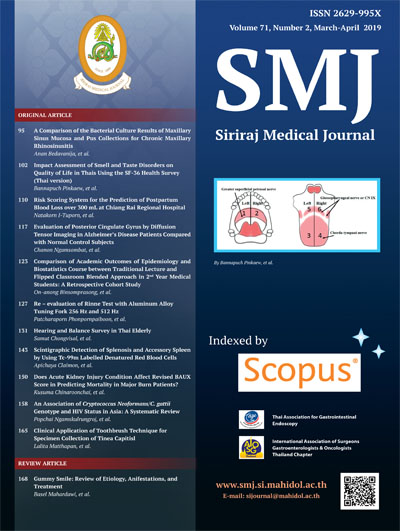An Association of Cryptococcus neoformans/ C. gattii Genotype and HIV Status in Asia: A Systematic Review
DOI:
https://doi.org/10.33192/Smj.2019.24Keywords:
Cryptococcosis; VNI; Cryptococcus neoformans; HIV; AsiaAbstract
Objective: It has been known that VNI molecular type of Cryptococcus neoformans/C. gattii is strongly associated with HIV patients. However, this paradigm has recently been challenged because of the high prevalence of VNI molecular type among non-HIV patients with cryptococcosis in East Asia. The purpose of this study was to answer
the question: “Among cryptococcosis in Asia, is there an association between the genotype and the patient’s HIV status?”
Methods: Using a systematic review and meta-analysis study design, we included all relevant published data, which were any type of study designs, mainly studied clinical Cryptococcus neoformans/C. gattii strains isolated in Asia and had available molecular typing data. The primary study variables were Cryptococcus neoformans molecular type (VNI/non-VNI or ST5/non-ST5) and the HIV status of the patients at the time of diagnosis. We used a randomeffects meta-analysis model to estimate the prevalence of HIV infection.
Results: Sixteen retrospective descriptive studies during 2005 – 2018 (1,584 isolates) were included. Most of the cryptococcosis cases in East Asian countries were in non-HIV patients (72.4-81.8%), which differed from non-East Asian countries (2.6-28.3% associated with non-HIV patients). In East Asia, the HIV prevalence among VNI
and ST5 infected patients ranged from 7.5% - 46.7% with the pooled prevalence of 19.8% (95% CI, 12.2% - 30.4%) and 5.3% - 52.4% with the pooled prevalence of 19.9% (95% CI, 6.9% - 45.3%), respectively. In non-East Asia, the HIV prevalence among VNI and ST5 infected patients ranged from 48.3% - 98.8% with the pooled prevalence of
81.9% (95% CI, 73.3% - 88.2%) and 52.3% - 88.0% with the pooled prevalence of 74.9% (95% CI, 40.7% - 92.8%), respectively. Statistical heterogeneity was high in both analyses with the I2 of 79-89% in all analyses.
Conclusion: Our results confirmed the low prevalence of HIV prevalence among VNI and ST5 strains in East Asian countries. The emergence of high virulence genotype causing disease in non-HIV patient is highly unlikely, because the VNI and ST5 were associated with HIV patients in other Asian countries. It can be hypothesized that
the low HIV prevalence among VNI and ST5 strains in East Asian is due to the high susceptibility to cryptococcosis of people living in this region. This requires further investigation.
Downloads
Published
How to Cite
Issue
Section
License
Authors who publish with this journal agree to the following conditions:
Copyright Transfer
In submitting a manuscript, the authors acknowledge that the work will become the copyrighted property of Siriraj Medical Journal upon publication.
License
Articles are licensed under a Creative Commons Attribution-NonCommercial-NoDerivatives 4.0 International License (CC BY-NC-ND 4.0). This license allows for the sharing of the work for non-commercial purposes with proper attribution to the authors and the journal. However, it does not permit modifications or the creation of derivative works.
Sharing and Access
Authors are encouraged to share their article on their personal or institutional websites and through other non-commercial platforms. Doing so can increase readership and citations.















